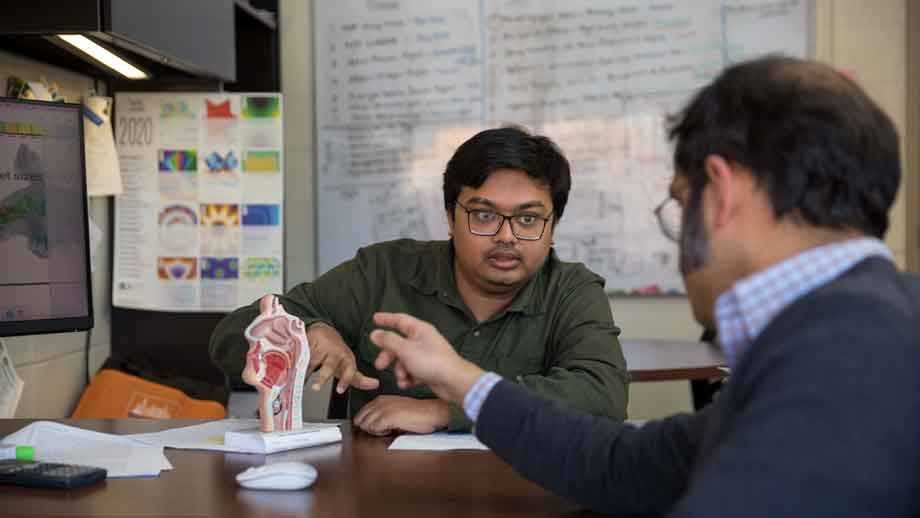
While fluid mechanics is considered an engineering discipline, its applications stretch far and wide into a variety of research areas. Taking that cue, Saikat Basu, an assistant professor in the South Dakota State University Department of Mechanical Engineering, and his research team have applied fluid mechanics modeling to cancer research with their latest project.
"The development, spread and treatment of cancer all have a connection to fluid mechanics," Basu explained.
The results of their work were recently published in the Experimental and Computational Multiphase Flow, a Springer journal, under the title, "Development of a multiphase perfusion model for biomimetic reduced-order dense tumors."
The project was done in collaboration with North Dakota State University's Center for Diagnostic and Therapeutic Strategies in Pancreatic Cancer (CDTSPC). Funding originally came via NDSU's CDTSPC pilot award program.
"The idea was to test whether we can build a fluid mechanics framework to model the basic flow physics in a tumor-inspired geometry," Basu explained.
Pancreatic cancer, according to the American Cancer Society, accounts for 3% of all cancers in the United States and around 7% of all cancer deaths. In 2023, the ACS projects around 64,050 people will be diagnosed with pancreatic cancer.
Pancreatic cancer—like many cancers—is characterized by tumors, which are solid mass and very dense. This makes it very difficult to predict or even quantify the amount of plasma (a component of blood) that will penetrate into the tumor, Basu explained.
"This is one of the aspects of cancer biology that makes it very difficult to track," Basu said.
Tumors are highly resistant to diffusive transport, which makes it very hard to accurately deliver drugs to fight off the cancerous tissues.
"It is very difficult for the drug to reach because solid tumors show very high resistance to that type of transport system because they are very high in their domain," said Mohammed Mehedi Hasan Akash, a Ph.D. candidate working under Basu's tutelage.
After discussing it with cancer researchers, Basu and his team came up with a quantitative model that can measure plasma penetration into a dense, solid tumor. Building a successful model could be an important contribution to cancer research in two ways, Basu said.
"No. 1, it could help us assess whether we can use the fluid transport for delivering drugs to the tumor, and No. 2, can this help us predict, based on the liquid penetration trend, whether a tumor is malignant or benign," Basu explained.
If the model could quantify blood flow into a tumor, then that information could be used to fine-tune drug delivery, Basu said. The different flow types may also make it much simpler to identify if a tumor is cancerous or not.
The two-dimensional model was built (and continues to be fine-tuned) entirely off medical imaging data from Basu's partners at NDSU.
"Our goal was to quantitatively assess plasma percolation trends into the solid tumor domain from the blood vessel," Hasan Akash said. "A purely mechanics-based model such as ours can open up new avenues in cancer research."
Basu worked with two students on this project. Hasan Akash is a fourth-year Ph.D. candidate whose primary academic focus is on fluid mechanics.
Nilotpal Chakraborty is currently a Ph.D. candidate at Virginia Tech at the Department of Biomedical Engineering and Mechanics. He worked on Basu’s project in 2021 as a fully remote undergraduate intern. A large portion of Chakraborty’s work on this project actually happened while at a university in India.
"The concept of a remote internship came to me in the latter part of 2020 when things were still mostly online—that’s how Chakraborty came on board," Basu said.
All the work and interactions between Basu and Chakraborty were done remotely and on weekend mornings, via Zoom and shared screens. The process underlines how working and mentorship in scientific research have been revolutionized over the last couple of years.
While the research team was able to publish its findings, there is still much more work to be done. In phase II of the project, the team will focus on incorporating more realistic biological renderings to the framework with more complex modeling challenges.
"This is just the start of this modeling approach for fluid mechanics and pancreatic cancers," Basu said. "There are so many things that can and should be added to this model to make it even more realistic. What we have right now is basically just the start. I anticipate we will be working on this project for at least the next three years."
As Basu notes, this type of modeling can hopefully help with future cancer treatments and/or diagnosis.
Reference:
Akash MM, Chakraborty N, Mohammad J, Reindl K, and Basu S. Development of a multiphase perfusion model for biomimetic reduced-order dense tumors. Experimental and Computational Multiphase Flow. 2023 Mar 5:1-1.
- Contact:
- Telephone number: 605-688-6161
Republishing
You may republish SDSU News Center articles for free, online or in print. Questions? Contact us at sdsu.news@sdstate.edu or 605-688-6161.

